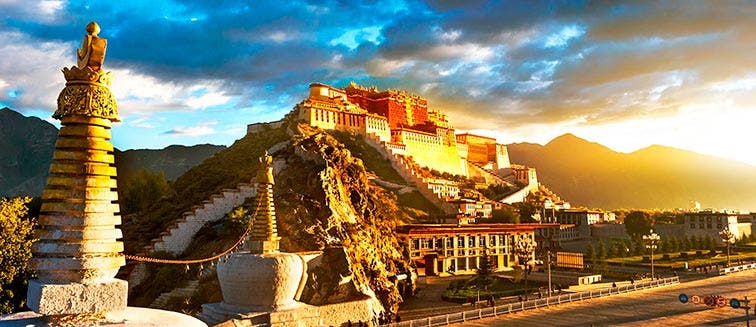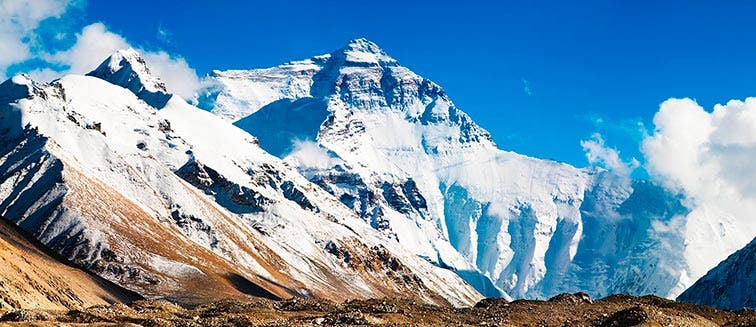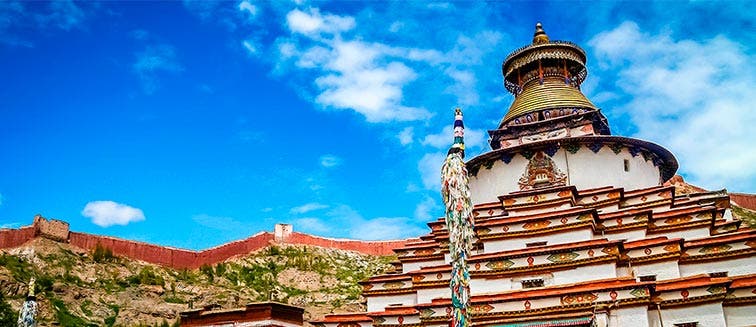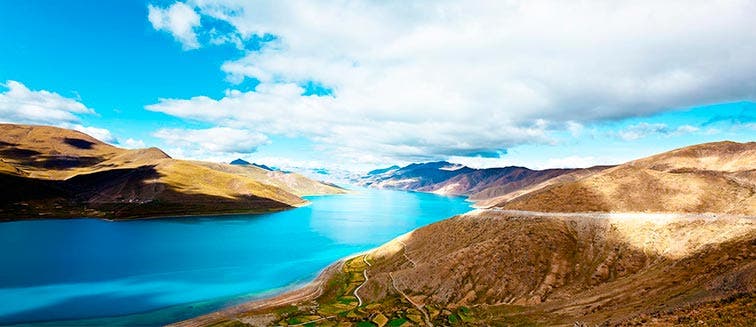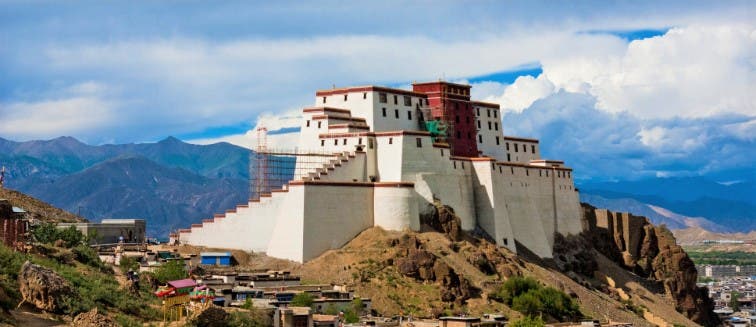Africa
Americas
Asia
Europe
Oceania
Call us for free now. 24/7
Book with an expert:
+44 20 76 60 34 10
What to see in Tibet
Lhasa
- Holidays to Tibet
- Points of Interest
Tourist attractions Lhasa
Lhasa is the capital of the Tibet Autonomous Region in China. It receives the nicknames of "The Earth of the Gods" for having been the home of the Dalai Lama, considered the living gods of the Tibetans. It is also referred to as "The Forbidden City", for its inaccessibility to foreign tourists. Protected by the Himalayan mountains, this remote and enchanting city is an isolated place in the middle of an endless plateau in the valley of the Yarlung Tsangpo River. Located at 3656 metres altitude, its landscape is semi-arid and the vegetation is reduced to willow forests, fields, shrubs and flowers in spring. It has very cold winters and warm summers and enjoys blue skies and intense sunshine for up to 3000 hours a year.The main tourist attraction in Lhasa is the well-known Potala Palace, declared a World Heritage Site by UNESCO. Its construction began in the seventh century when the 33rd warrior king of the Songsten Gampo Tube established the capital of the kingdom of Tibet in Lhasa. At that time, it was called the Palace of the Red Mount and after suffering storms, wars, and even being abandoned for hundreds of years after the fall of the kingdom, in 1648 the 5th Dalai Lama Lobsang Gyatso, completed its reconstruction, although it was not until the beginning of the 20th century that it reached its current dimensions due to the reforms made by the 13th Dalai Lama. It was the governmental and religious seat for more than 300 years until the last Dalai Lama went to India, in 1959. Today it functions as a museum and sanctuary.The name of the tallest palace in the world comes from Sanskrit and means "Land where the Buddha of compassion lives", a beautiful place from which he dominates the world and saves people.Built on Hongshan Mountain, the architectural complex, a paradigm of Tibetan art, is composed of the palace itself, the atrium and the garden and its 13 levels, measuring 117 metres in height and 400 metres in width. It was built in stone and wood and its imposing façade of superimposed structures culminates in the central Red Palace, the pavilions of the White Palace and a yellow annexe building that houses the embroidered ceremonial flags. Its granite walls lean slightly inwards and reach a maximum thickness of 5 metres. The windows appear parallel and bordered by a strip of black lacquer, increasing in size as they gain in height. Each year the palace is painted using a mixture of milk, sugar, honey, herbs and white lime.The 13 main buildings contain 1000 compartments, 10,000 chapels and 200,000 statues and the 7 new roofs are Chinese in style and golden in colour. The decoration of its interior, which can only be seen by the eye as it cannot be photographed, is a festival of colours in the form of beautifully sculpted and polychrome woods, murals that tell the history of the country, embroideries, hanging scrolls, fabrics, thangkas and thick sheep wool carpets that cover ceilings, walls, pillars and floors of halls, corridors, halls, galleries, chapels and sanctuaries.The White Palace includes pavilions facing east and west of the building, home to offices, meeting rooms, study and meditation areas, a printing press and private rooms for the Dalai Lama and Buddhist priests or bonzes. The highlights are the Deyangsha Plaza, in which the Great Lama carried out his outdoor activities; the Dongyoujiyuanman Hall, where the enthronement ceremony and other political activities such as the granting of titles were held; and the Pavilion of the Buddhas, which houses the statues of the lamas and the founder of the yellow sect.The Red Palace, the most sacred building, is completely dedicated to religious studying, reading sutras and praying in halls, chapels and sanctuaries where colour is also used as a seal of ornamentation. The Western Hall is dedicated to the memory of the 5th Dalai Lama and exhibits his throne and 44 columns with beautiful and elaborate reliefs of animals, flowers and Buddhist motifs. The Sacrifice Hall is the largest and has the most luxurious door in the entire complex, meticulously crafted in gold and bronze and guarded by two white lions. It houses 8 funeral stupas where the embalmed remains of the 5th to 13th Dalai Lama rest. The tomb of the 5th is the most spectacular and appreciated. It is almost 15 metres high and is covered with 3700 kg of gold, silver, diamonds, corals, turquoises, pearls and agates. The palace's private treasury also includes collections of books, ceremonial garments, brocades, Chinese porcelain, cloisonné enamels, unique gems, jewellery, and other religious objects. The best photographs of the Potala Palace are available from the central Barkhor Square where the Jokhang Temple is located; from the grand Potala Square where the Monument to the Peaceful Liberation is located; from the viewpoint of Yaowang Mountain, on the corner of Beijing Middle Road and from the back of the path of the kora, near to Zongjiao Lukang Park, on whose trees surrounded lakes the inverted silhouette of the building is reflected. Legend has it that when the trench was opened to build the palace, a spring of crystalline and sweet water sprang up. All believed that it was a miraculous source that the dragon king gave to the palace, granting more beauty, if possible, to the majestic construction. Do not forget that the image of the palace under the light of the moon is fantastic and essential to admire since the building enjoys great night-time lighting.The kora is the sacred pilgrimage carried out by the Tibetans, which consists of walking around a Buddhist temple to purify karma and cleanse the spirit, always in a clockwise direction. Normally one complete circuit is made, but sometimes 3 turns are made to draw concentric circles. The first inside the temple, the second around the temple and the third bordering the village limits.Everyone who has wished to travel to Tibet has imagined themselves in front of the Potala Palace observing the pilgrims with amazement and emotion. And that is exactly what it causes. The experience does not disappoint, on the contrary, it is a more beautiful and grand experience that you can imagine.
In the heart of Lhasa, is the Jokhang Monastery, the most important temple of Tibetan Buddhism and the first spiritual centre of pilgrimage. It is considered a World Heritage Site along with the Potala Palace and the Norbulingka. King Songtsen Gampo had it built around the year 662 to house the most sacred statue in the country, that of the Buddha in the lotus position and the Jowo Sakyamuni statue, brought by the Chinese princess as a dowry, and blessed by Siddharta Gautama himself. The name of the monastery, Jokhang, means the "House of the Buddha".One of the popular stories that exist about its construction, explains that the king threw his ring in the air to determine the place where to raise the temple. It fell into a lake from which emerged a stupa, filled with earth transported by thousands of white rams, the reason for which the city received its first name of Rasa or "Land of the Ram".The materials used to construct this 4-floor building were mud and wood. You can see the Nepalese and Indian style in the sculptures, the Tibetan influence in the watchtowers, columns and sculptures, carved in sandalwood, and Han influence on the colourful roofs covered with gilded bronze tiles and adorned with sculptures of animals, beasts and bells.The main entrance has a large Dharma wheel of 8 vanes representing the Buddha's eight paths to enlightenment and is flanked by two deer to remember that the sage gave his first sermon in a park where these animals lived. In front of it, there is a tombstone that symbolizes the reconciliation between Emperor Muzong of the Tang dynasty and the King of the Law of Tubo, in which the vow was made not to be enemies and not to get involved in the war. Beside it is an old willow tree that according to the story, was planted by the Princess Wen Cheng.On the ground floor, after crossing the main entrance guarded by the statues of the four guardian kings, you can access the main meeting room, where there is an outdoor patio surrounded by colourful and detailed frescoes on the walls and the main hall of prayers, around which smaller chapels are arranged.The second floor houses a room with the sculptures of the king and the princesses, the official Lu Dongzan and the creator of the Tibetan language. On the inner altar, there is a 6 metre tall statue of the Buddha of compassion and another of the Buddha of the future. From the terrace, you can enjoy magnificent views of the monastery and its courtyard, Barkhor Square and the Potala Palace in the background.Contemplating the fervour and devotion of the thousands of pilgrims who visit it every day, is one of the most amazing and incredible experiences that can be had on a trip to Lhasa. Barkhor is the street that borders the Jokhang Temple and is full of colourful traditional facades adorned with fabrics and prayer flags where there are food, craft and textile shops and restaurants. The Jokhang kora, measuring 800 metres, is the religious circumambulation circuit of the monastery that the pilgrims walk in a clockwise direction. On the way there are 4 large censers placed at each cardinal point, used by the devotees as they pass, who pray as they walk or prostrate on the ground dozens of times, count the 108 beads of their Tibetan rosaries and turn the prayer wheels and the molinillos that they carry in their hands.At 1 km south of the Potala Palace is the Norbulingka Palace, built by the 7th Dalai Lama as a summer residence. It houses both the old and the new building, built for the 14th Dalai Lama. The rooms remain intact from his exile and among them stands out the Audience Hall with an impressive golden throne and beautiful frescoes that represent the history of Buddhism, a meditation room and private bedrooms.The Sera Monastery, the second largest in Tibet, is another important monument that is located near the capital, specifically 6 km away, and which is well worth a visit especially to witness the famous debates of the monks in the backyard. Their excessive gestures and vehemence are striking, raising their voices and hands and clapping their hands to express their emotions and defend their philosophical arguments about the scriptures.The walls of the building are made of stone covered with white plaster and are adorned with a reddish border at the top below the roofs. The windows, which as they gain in height also increase in length, are framed with a black stripe and from their borders hang cloth flaps. The meeting room is the most important area of the building, which is full of exquisite tangkhas or tapestries and houses a 6 m high Jamba statue.The religious institution of Sera is considered the University of Buddhism since the examination to obtain the title of the highest academic degree of Tibetan Buddhism is taken here.The Drepung Monastery, located 8 km from Lhasa, at the foot of the Gambo Utse mountain, is one of the most relevant. Its name means "mountain of rice" referring to the white colour of its buildings that resemble, from a distance, the grains of crop.It was founded in 1416 by a disciple of the founder of the monastery order of Gelugpa and at the time it was the largest in the world. It included 141 estates and 540 pastures and came to hold at least 10,000 monks. It was the residence of the Dalai Lama before the 5th of the spiritual leaders moved to the Potala Palace.Currently there are about 700 monks and 4 schools remaining, which are dedicated to the intensive teaching of traditional Buddhist arts and sciences such as theology, metaphysics, philosophy and geography.In 2008 it was closed for the violent protest that some monks staged against the Chinese government and it was not opened to the public until 2013.Following its kora route, the tour takes visitors first to the Ganden Phodrang Palace, the residence of the 2nd, 3rd, 4th and 5th Dalai Lama, where you can find the Sanga Tratsang Room and the statue of the 5th Dalai Lama. Continuing, visitors reach the courtyard and the main Coqen Hall building that includes the Tsokchen kitchen and meeting room, which has 180 columns, thangkas and several chapels, among which the chapel of the Kings of Tibet stands out, as does the Sakyamuni Chapel full of chortens; the Hall of Maitreya, or the Buddha of the Future, the most venerated image of the monastery and the Drölma Chapel, where there are three images of this deity and several collections of books with highly valued writings. The kora continues through the chapels of the Ngahpa, Loseling, Gomang and Deyang schools, which houses the image of Jampa, the most beloved of this school, in its main hall.Travelling to Lhasa is an unforgettable experience. A spiritual journey, it is true that incipient progress is perceived in the huge avenues of the new neighbourhoods built by the government of China, but luckily, it still maintains the old centre and the traditional customs of the Tibetans, who carry Buddhism in their blood. The atmosphere is unique: monks chanting their mantras with a deep voice, pilgrims following the kora, hundreds of prayer flags moving in time with the wind, the smell of incense and candles made of yak butter in the temples ... and everything under the mystical protection of the high mountains and the watchful eye of the soldiers of the Chinese army.
We don't have any trips to Lhasa at the moment.
Subscribe to our newsletter to not miss any trips
YOU ALSO LIKE
China
5 Trips
Hong Kong
6 Trips
Japan
9 Trips
Mongolia
Notify me when available
South Korea
4 Trips
Taiwan
Notify me when available
Tibet
Notify me when available
Jordan
7 Trips
Israel
Notify me when available
Armenia
Notify me when available
Uzbekistan
1 Trips
Oman
1 Trips
Lebanon
Notify me when available
Kazakhstan
Notify me when available
Kyrgyzstan
Notify me when available
Cambodia
4 Trips
Thailand
13 Trips
Vietnam
9 Trips
Myanmar
Notify me when available
Indonesia
6 Trips
Malaysia
3 Trips
Philippines
5 Trips
Singapore
3 Trips
Laos
Notify me when available
India
14 Trips
Bhutan
1 Trips
Turkey
9 Trips
Nepal
4 Trips
Sri Lanka
5 Trips
Maldives
6 Trips
United Arab Emirates
6 Trips
Saudi Arabia
1 Trips
Tourist attractions tibet
Points of interests
Other Points of interests
- Trips to Andong
- Trips to Beijing
- Trips to Busan
- Trips to Chengdu
- Trips to Chongqing
- Trips to Dunhuang
- Trips to Guilin
- Trips to Gyeongju
- Trips to Hakone
- Trips to Hangzhou
- Trips to Hiroshima
- Trips to Hokkaido
- Trips to Hong Kong
- Trips to Huangshan
- Trips to Jeju Island
- Trips to Jeonju
- Trips to Jiuzhaigou National Park
- Trips to Kanazawa
- Trips to Kumano Kodo
- Trips to Kyoto
- Trips to Lantau Island
- Trips to Lhasa
- Trips to Li River
- Trips to Matsumoto
- Trips to Mount Fuji
- Trips to Mount Koya
- Trips to Nagoya
- Trips to Nara
- Trips to Nikko
- Trips to Okinawa
- Trips to Osaka
- Trips to Repulse Bay
- Trips to Sapporo
- Trips to Seoul
- Trips to Shanghai
- Trips to Shirakawa-go
- Trips to Stanley Market
- Trips to Suzhou
- Trips to Taipei
- Trips to Takayama
- Trips to Three Gorges Dam
- Trips to Tokyo
- Trips to Ulaanbaatar
- Trips to Victoria Peak
- Trips to West Lake
- Trips to Wuxi
- Trips to Xi'an
- Trips to Yangshuo
- Trips to Yangtze river
- Trips to Yeosu
- Trips to Zhangjiajie
Countries Nearby
- Armenia Trips
- Bhutan Trips
- Cambodia Trips
- China Trips
- Hong Kong Trips
- India Trips
- Indonesia Trips
- Israel Trips
- Japan Trips
- Jordan Trips
- Kazakhstan Trips
- Kyrgyzstan Trips
- Laos Trips
- Lebanon Trips
- Malaysia Trips
- Maldives Trips
- Mongolia Trips
- Myanmar Trips
- Nepal Trips
- Oman Trips
- Philippines Trips
- Saudi Arabia Trips
- Singapore Trips
- South Korea Trips
- Sri Lanka Trips
- Taiwan Trips
- Thailand Trips
- Tibet Trips
- Turkey Trips
- United Arab Emirates Trips
- Uzbekistan Trips
- Vietnam Trips
Trip Styles
- Indian Subcontinent Tours for Couples Trips
- Indian Subcontinent Nature Tours Trips
- Adventure in India's Natural Beauty Trips
- Indian Ocean Nature Holidays Trips
- India Couples Tours - Exoticca Trips
- Family India Trips
- Indonesia Nature Travel Packages Trips
- Family Japan Trips
- Romantic Getaways with Exoticca Trips
- Nepal Nature Holiday Packages Trips
- Philippines Nature Tours Trips
- Family Thailand Trips
- Thailand Nature Holiday Packages Trips
- Turkey Tours for Couples Trips
- Vietnam Nature Holiday Packages Trips
Subscribe to our newsletter and join Exoticca GO
The best travel deals
Exclusive promotions
Expert travel tips
